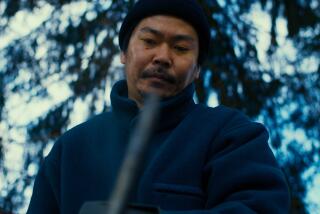‘The Wind Rises’: Five things to know about Miyazaki’s new movie
- Share via
Across the Pacific, Hayao Miyazaki has already created a hit and a conversation piece with “The Wind Rises,” his look at the early days of aviation and the fictionalized formative years of Japan’s Zero airplane creator Jiro Horikoshi as he becomes a star engineer. The animation legend’s first movie in five years — and probably his last ever -- “The Wind Rises” has become a box-office hit in Japan since opening in July and generated plenty of op-ed talk for its political content.
In examining a man who created a plane that would become key to Japan’s efforts in World War II, the film, titled “Kaze Tachinu” in its native Japanese, has the whimsy of much of the director’s work but with a patina of ideology. Miyazaki hasn’t been silent either, recently publishing an essay opposing Prime Minister Shinzo Abe’s plan to rebuild the military.
Judging by reaction to the film as it’s played the festival circuit — it’s next up for a stop in New York after previous swings to Venice, Telluride and Toronto — it will be a talker on this side of the world too. Here are five key themes and symbols to know about the movie before its Oscar-qualifying run in November and commercial release Feb 21. (No spoilers, but some plot points are discussed.)
Militant notions. Miyazaki in the past few months has generated criticism from both the right (for his Abe critique) and the left (for chronicling/glorifying a man who designed warplanes). Politics don’t run through every scene of the movie, which is as much a love story as anything else, but when they do make an appearance it’s with some force. Early in the film, a man in Jiro’s reverie — the Italian aviation figure Giovanni Caproni, who recurs in the hero’s imagination — tells the young Jiro that “airplanes are beautiful dreams” and warns against using them for destructive purposes. Later, there are ominous references to the “thought police” and the suggestion that dark militaristic forces are going to co-opt Jiro’s talent for violent ends. There’s also a caricature-ish depiction of the Japanese navy.
Animal instinct. Miyazaki is known for a gentle mysticism involving all parts of the spirit world. That includes animals, which get several call-outs here. A well-designed plane is referred to as a “full-metal duckling” (the opposite of an “ugly tin duckling”). There’s a humorous scene in which oxen are used to pull airplane parts. And Jiro gets inspiration from the shape of a bone found in a mackerel, prompting him, after looking at some well-made American designs, to drolly remark, “Americans eat mackerel too?”
Magical realism. As this is a Miyazaki movie, there’s plenty of magical realism. In the airplane dream Jiro is able to walk over the plane as Caproni tells him, essentially, “We can’t go up here, but in a dream you can go anywhere.” Later in the movie a door is able to take flight, while a paper airplane is capable of some physics-defying tricks.
Big in Japan. The tension between patriotism and self-criticism is heavily at play in this portrayal of a pre-WWII Japan, which questions the subjective nature of progress and the particular ways Japan forged its identity in the 20th century. “Is Japan a modern country?” is a question asked often, both literally and figuratively. Deadly earthquakes and tuberculosis epidemics are present, suggesting a tragic lack of modernity. But there’s also a sense amid all that of a filmmaker who feels deeply connected with the land — bonds that the war would sever.
Windy City. Perhaps the biggest symbol in the movie is, of course, the wind. That takes a concrete form as Jiro designs a plane meant to reduce wind resistance, and as he and Caproni try to escape a fire as the former warns of the danger because “the wind is rising.” But it’s also a symbolic presence, introduced to represent the intangible power of imagination to carry us. And it’s an animating force in the movie’s romance. As Jiro’s great love, Nahoko, tells him, the wind brought him to her.
ALSO:
Animator Hayao Miyazaki to retire from making films
‘The Wind Rises’: Hayao Miyazaki’s new film stirs controversyMiyazaki’s ‘Wind Rises’ to get Oscar-qualifying run in November
Twitter: ZeitchikLAT
More to Read
Only good movies
Get the Indie Focus newsletter, Mark Olsen's weekly guide to the world of cinema.
You may occasionally receive promotional content from the Los Angeles Times.











